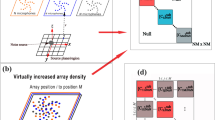Abstract
In this paper, we focus on the reverberation depression in scenarios such as hand-free telephone and teleconference system applications. The combination of cross-relation based blind room impulse response (RIR) estimation and the p-norm based channel reshaping leads to this adaptive reverberation depression scheme. The normalized multi-channel frequency-domain least-mean-square (NMCFLMS) algorithm is used for RIR estimation and the p-norm optimization approach for channel reshaping. Simulations show that it is possible to establish such a post-processing system for reverberation depression. Listening tests verified that reverberation is hardly heard after channel reshaping.





Similar content being viewed by others
References
Ahmad, R., Khong, A. W. H., Hasan, M. K., & Naylor, P. A. (2006). An extended normalized multichannel FLMS algorithm for blind channel identification. Proceedings of European Signal Processing Conference.
Allen, J. B., & Berkley, D. A. (1979). Image method for efficiently simulating small-room acoustics. The Journal of the Acoustical Society of America, 65(4), 943–950.
Buchholz, J., Mourjopoulos, J. and Blauert, J. (2001). Room masking: Understanding and modelling the masking of room reflections. In Proceeedings of the 110th Convention of the Audio Engineering Society. Amsterdam, Netherlands, May 2001, Paper 5312.
Dau, T., Kollmeier, B., & Kohlrausch, A. (1997). Modeling auditory processing of amplitude modulation, I. Detection and masking with narrow-band carriers. The Journal of the Acoustical Society of America, 102(5), 2892–2905.
Fielder, L. D. (2001). Practical limits for room equalization. In Proceedings of the Audio Engineering Society Convention 111. Audio Engineering Society, pp. 1–19.
Fielder, L. D. (2003). Analysis of traditional and reverberation-reducing methods of room equalization. Journal of the Audio Engineering Society, 51(1/2), 3–26.
Hasan, M. K., Benesty, J., Naylor, P. A. & Ward, D. B. (2005). Improving robustness of blind adaptive multichannel identification algorithms using constraints. In Proceedings of the European Signal Processing.
Huang, Y. & Benesty, J. (2002). Adaptive blind channel identification: Multi-channel and least mean square and Newton algorithms. In Proceedings of the IEEE International Conference on Acoustics, Speech, Signal Processing.
Huang, Y., & Benesty, J. (2003). A class of frequency-domain adaptive approaches to blind multichannel identification. IEEE Transactions on Signal Processing, 51(1), 11–24.
Karjalainen, M., & Paatero, T. (2007). Equalization of loudspeaker and room responses using Kautz filter: Direct least squares design. EURASIP Journal on Advances in Signal Processing, 2007, 1–13.
Liao, L. & Khong, A. W. H. (2010). A noise robust multichannel algorithm for blind estimation of room impulse responses. In Proceedings of the12th International Workshop on Acoustic Echo and Noise control (IWAENC).
Maamar, A., Kale, I., Krukowski, A., & Daoud, B. (2006). Partial equalization of non-minimum-phase impulse responses. EURASIP Journal on Advances in Signal Processing, 2006, 1–8.
Mertins, A., Mei, T., & Kallinger, M. (2010). Room impulse response shortening/reshaping with infinity- and p-norm optimization. IEEE Transactions on Audio, Speech, and Language Processing, 18(2), 249–259.
Moulines, E., Duhamel, P., Cardoso, J. F., & Mayrargue, S. (1995). Subspace methods for the blind identification of multichannel FIR filters. IEEE Transactions on Signal Processing, 43(2), 516–525.
Naylor, P. A., Gaubitch, N. D., (2005). Speech dereverberation (2005). International workshop on acoustic echo and noise control (pp. 12–15). The Netherlands: Eindhoven.
Shynk, J. J. (1992). Frequency-domain and multirate adaptive filtering. IEEE Signal Processing Magazine, 9, 14–37.
Xu, G., Liu, H., Tong, L., & Kailath, T. (1995). A least-square approach to blind channel identification. IEEE Transactions on Signal Processing, 43(12), 2982–2993.
Author information
Authors and Affiliations
Corresponding author
Rights and permissions
About this article
Cite this article
Mei, T., Hang, P. & Mertins, A. Adaptive estimation and reshaping of room impulse response. Int J Speech Technol 18, 91–95 (2015). https://doi.org/10.1007/s10772-014-9252-6
Received:
Accepted:
Published:
Issue Date:
DOI: https://doi.org/10.1007/s10772-014-9252-6




